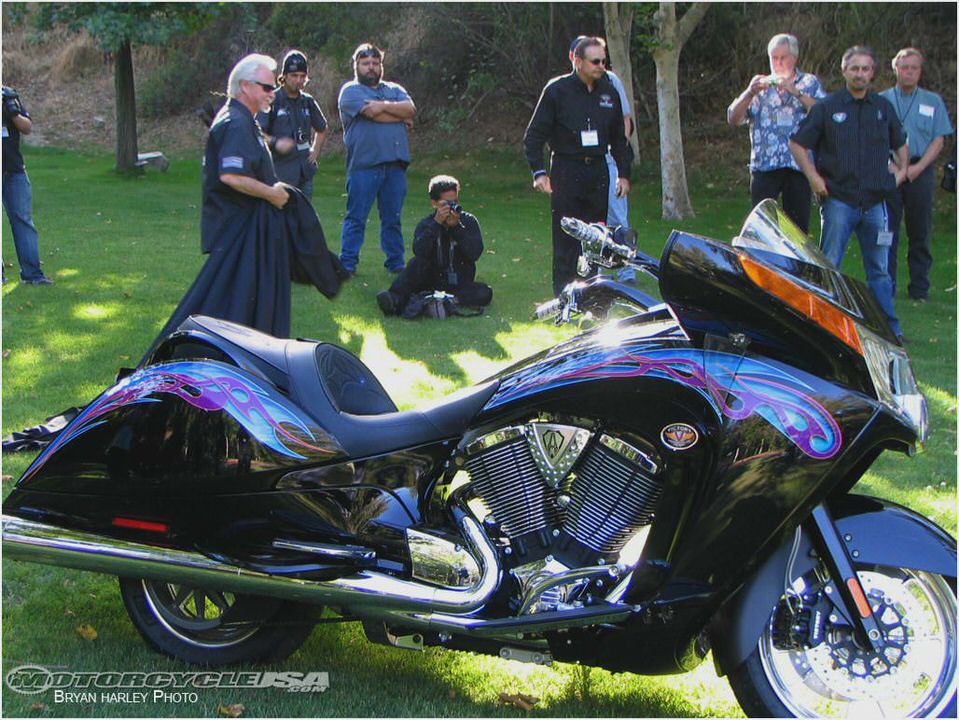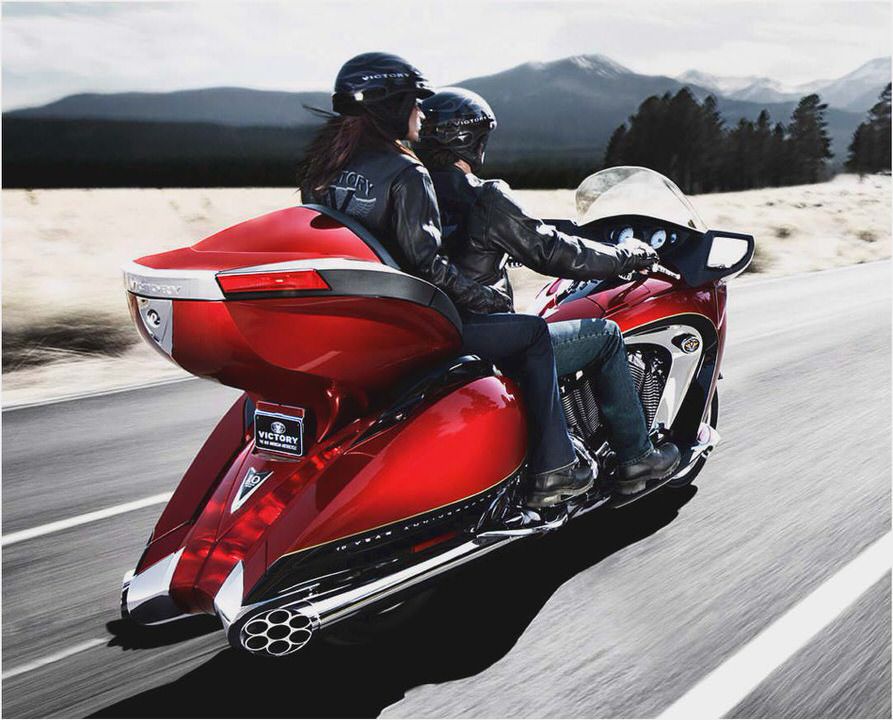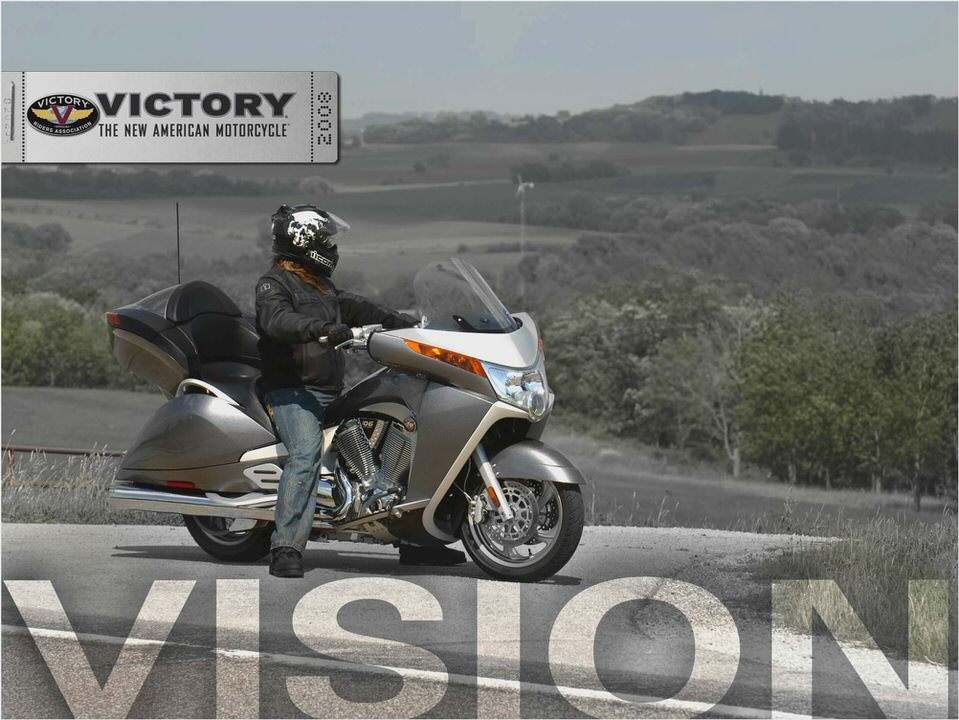0805_hrbp_17_z+2008_victory_vision+riding_rear_view.jpg
What: Victory Vision Street and Vision Tour
When: January 2008
Where: Los Angeles, Ventura and Orange County, California
Why: Riding impression, evaluation and commentary
How: Admittedly, before I begin, there’s a confession that must be made: My thoughts about the Visions are as confused as to what category these bikes belong. That’s not necessarily something unsavory. While undoubtedly attractive and unique in appearance, the plastic-ensconced uber-physique is reminiscent of, yes, a large scooter.
OK, I said it, you may have thought it. Not that there’s anything wrong with that, it was just my (and many others’ in an informal, completely impartial, independent survey) initial notion. I feel better getting that out of the way.
These bikes are so outside the proverbial box of the typical rendition of a cruiser/tourer that we had to establish a new set of judging criteria. For the record, Victory characterizes the Vision Street as the Complete Cruiser and the Tour as the Ultimate Luxury Tourer. Other than the Tour’s rear-mounted trunk (with speakers) that adds about 45 pounds to the bike, both bikes are identical in motor, trim and options.
Our two test units came quipped with the Premium package, consisting of factory-installed options such as power windshield, heated seats and grips, high-intensity discharge headlight and an assortment of chrome accoutrements. The Premium package adds $1,500 to the base price of each bike, while a Comfort package ($500 with Premium features minus the HID light and extra chrome) for the Tour is also available.
Exclusive to the Vision platform is Victory’s newly engineered 106ci Freedom powerplant-the company’s largest ever. Like previous incarnations, the motor features two overhead cams and four-valve heads along with air/oil cooling. But this motor is more than just a stroked 100-incher; it has a new crankcase, cams, covers and primary drive that were all designed to make more power while producing a quieter, government-friendly auditory note.
Facilitating the increased displacement are new pistons, rods and crankshaft. On the fuel management side of things, a new brain was employed to decipher the closed-loop fuel injection message that reduces emissions while maximizing drivability and performance under varying atmospheric conditions. All of this adds up to a torque-monster of an engine that purportedly pumps out 92hp with 109 lb-ft of torque.
It’s definitely peppy and has no problem moving around the large bikes.
Perhaps the biggest divergence from traditional tubular or square motorcycle frames is the Vision’s monocoque frame that serves to not only suspend the motor but is also a massive airbox (see Oct. 2007 issue, page 30 for stripped-down images). The cast-aluminum part, borrowed from the sportbike world, allows large amounts of air to enter the motor; remember, a motor is just a big air pump, so more air in and out means more power.
Like the rest of the Victory lineup, the six-speed overdrive transmission is contained within the engine case. To account for the extra weight, the Vision gets different gear ratios (higher sixth and lower first) that aid in acceleration and smoothness.
So far I’ve recounted mostly boilerplate ad copy. The meat of this evaluation should really be settled on the street-the absolutely chaotic, ever-busy, fast-moving LA megalopolis. Within an hour’s ride anywhere in SoCal, one can experience the urban to the desert, the urbane to the worst roads in the country, with some of the best mountain twisties anywhere thrown in for some therapeutic adrenaline.
Although not our first time saddling a Vision, it was our first ride without the Victory chaperones, the flock of moto-journalists and the sedate Midwestern roads we traversed earlier last year. Just like that previous trip to the Victory mother ship in Minnesota, it was raining when we went to pick up the two bikes. Straddling the Vision’s girth and might for the first time was a pleasant experience owed largely to the low 261/2-inch seat height combined with the frontend geometry.
Although clocking in at over 900 pounds, the bike was easy to get off the (too-long) sidestand and maneuver around a tight parking lot. While we appreciated how easy it was to stand the bike up, the kickstand length makes the bike sit up straighter than we’d like, often requiring judicious parking placement to assure stability. We never got to test it but thought the bike may not stand up with a flat tire.
The long, funky, oval-rectangular, nonadjustable handlebars were a comfortable reach, although we experienced some interference when making tight turns as they came close to your body. After suiting up for the trip back to our secret offices, we limped the fume-filled bikes to the nearest gas station, where we tried to figure out where and how to put in the needed gasoline.
It turns out that if the ignition key is turned toward the lock label (a loose black ring around the ignition switch), a door pops open on the right, top side of the faux fuel tank, revealing a single gas cap with a nifty cap holder molded in next to it. The real fuel repository (out of sight beneath the plastic) consists of two aluminum gas tanks that straddle the frame and the top of the fork.
I had learned on my previous Vision ride that the two 3-gallon tanks are connected with an extremely slow crossover tube. This situation requires many starts and stops while filling up to ensure the gas from the main tank (where the filler is) fills the second tank. We had to fill, wait and watch the level go down as it filled the other and continue filling again until we thought we were done.
It’s a pain, and I’d rather absolutely know every time that my bike is filled up without having to go through a routine. With the bars turned to the left, pushing in the key and turning toward the lock position activates the fork lock and sometimes opens the gas door, too. While in the locked position, the left tank storage compartment also locks.
Both compartments are nice to have, but the bars interfere with the opening of the doors, oftentimes requiring moving the bars to either fill up or access the storage compartment.
Once we were fueled up, it was time to hit the freeway. Thanks to the new fuel management system, both bikes started up effortlessly with perfect idle control. Initial seating comfort was good due to the extremely cushy 4 inches of padding beneath our bodies. Approaching the first big sweeper while merging with big rigs told us these were not your grandpapa’s bikes.
Stability and particularly suspension compliance during midcorner perturbations was nothing short of exceptional. Before I go on, let me say this is the best-handling Victory model ever. Poor straight-line tracking has always been an issue with all previous Victory models we’ve tested, but the Vision requires no rider input to keep it going where you want. No matter how hard the bikes were pushed, there was never a wobble or shimmy, and hitting hard parts in turns is almost impossible.
Although the motor is slightly noisy, it delivers all the power you need at almost any rpm. Gearing seemed perfect with plenty of power available, even in sixth gear as long as the rpm were above approximately 2500 (about 70 mph). With so much traffic around, cruise control isn’t one of my preferences, but I tested it a few times.
It worked well and was easy to engage and control with the right-side handlebar pod. My only complaint is when disengaging the cruise control, the throttle is chopped closed by the return spring on the throttle body. Not a huge deal but not nearly as refined or smooth as H-D’s. Linked brakes did a great job of controlling the weight. When the rear brake pedal is depressed to a preset amount, one piston in each of the front three-piston calipers is also activated.
It worked seamlessly and prevented dive while not affecting the feel or operation of the front brake lever. No ABS is available, but we feel it isn’t needed.
Victory went to great lengths to have form follow function. Much of the shape of the bike was designed, tested and perfected in a wind tunnel to provide the rider with a great riding experience. Up front, the massive 45-inch-wide fairing did a fine job of wind and rain isolation. We really liked the electronically adjustable windscreen that could be moved up to 31/2 inches on the fly.
In the lowest position, the top of the screen was just about at nose height for the average rider while well above eye level in the highest position. This was nice to have as the weather turned from sunny to rainy. Even though air gets to the rider’s head in the low position, no buffeting was evident.
Adjustable, laterally mounted wind deflectors on each side of the fairing also did an excellent job of wind and cockpit heat management. The only mildly annoying wind was found to move up the rider’s back and into the back of the helmet. Head winds weren’t much of a problem for bike stability; however, strong crosswinds often gave the bike a mind of its own.
With not much daylight seen through the bike, all of that surface area is ideal for wind gusts to grab.
While riding, we noticed that the instrumentation was easy to see and evaluate. Aside from the normal speed, rpm, battery voltage, fuel gauge and idiot lights, there is an LCD display with gear indicator, time, temperature and a myriad of fuel- and mileage-related parameters. Things like average and instantaneous gas mileage, miles to empty, two resettable tripmeters and an overall odometer are among the data available.
The main audio controls and screen are integrated into the center of the tank panel while a left handlebar pod lets the rider have audio control at the fingertips. Standard radio functions are AM and FM radio that gets subaverage reception from its hidden antenna. An MP3 player can be attached through the auxiliary cord found in the left-side tank compartment.


With the optional iPod cord, the player can be charged while riding and have song info displayed on the Victory screen. The four-speaker Tour system sounded much better than the two on the Street, but both were good with nice bass and treble response even when riding with a full-face helmet with earplugs in. Pod controls were a bit small to be used with heavy gloves and sometimes changed stations while attempting to raise the volume.
Scan and seek functions both seemed to do the same thing, neither of which was scan nor seek. When the tank-mounted buttons were used, the power button was frequently turned off due to its placement right under where the palm comfortably rests. Since we’re on electronics, the blinkers usually had a mind of their own-staying on too long after a turn and sometimes going off well before a turn.
Most frustrating was the manual turn-off feature (pushing in the turn signal switch) that sometimes worked to turn off the flasher, but at other times just kept the signal on. Turn signals are intimately linked to life and death, and the constant signal distraction was something we just shouldn’t have to deal with.
Continuing along the less-than-satisfied thread are the mirrors. Although they are as large as on most automobiles, their placement was obviously a form-over-function scenario, as the rider cannot see directly behind the bike. While we were riding, the majority of the mirror view was the back of our hands. Removing a hand and moving outward gave a barely better view that was dominated by the hand control.
It’s an absolute deal breaker for any motorcycle to have such poorly designed mirrors-a safety and awareness issue that there is no excuse for. It’s not like the almost-4-foot-wide fairing couldn’t accommodate some kind of useful mirrors.
Rider floorboards are extremely long and comfortable, allowing numerous leg positions while riding. Unfortunately, the passenger boards aren’t nearly as roomy and are too close to the back of the rider’s legs. Female passengers with tiny feet had to reposition at every stop in order to not get tangled up with the rider. The passenger boards are located on top of the tip-over protectors that bolt to the frame.
These rounded bits had a tendency to trap the rider’s leg when taking off from a stop. This happened to at least half a dozen experienced riders. Being completely aware of the issue did not prevent my foot and boot from getting sucked under the contraption and painfully bent back.
For such a large bike, there needs to be more space in this area. The two passengers I personally had on the bike were not comfortable with the seating arrangement, as the saddlebags prevented a comfortable reach to the boards. The length of the passenger seat made it difficult for a petite- to average-sized woman to sit all the way back on the seat.
A compromise had to be reached where the bags weren’t in the way, the feet weren’t in the rider’s way and the passenger could position themselves on the seat comfortably. Seemed like an awful lot to think about.
Cruising along the interstate with a passenger posed no handling problems, but that changed a bit when the road got curvy and steep. The passenger sits far back on the Vision, which tended to upset the handling when attempting spirited mountain riding. With a 100-pound passenger and 150-pound pilot, the Tour sometimes felt hinged in the middle during turning transitions, with the front turning independently from the rear.
We pumped up the rear air suspension per Victory specs but didn’t feel much of a difference.
Both bikes have a very similar ride and feel. The trunk on the Tour didn’t upset the handling in any way, although we never had more than the 20-pound limit inside the box. Two full-face helmets could be squeezed into the trunk, which was very nice to have. Unfortunately, the trunk opens toward the front of the bike, preventing the easy use of a T-bag on the passenger seat.
Likewise, the trunk cannot be opened while a passenger is on the bike. Everyone on staff was in agreement that the storage solutions on these bikes were quirky and not very touring-friendly. While the side-opening saddlebags look spacious, they are awkwardly shaped and don’t hold much gear. Because the bags are side-loaded, the contents have a tendency to fall out and often required repositioning to get the bag closed.
Many times the bags needed numerous attempts to close, even when empty, and in one instance the bag opened while riding. Thanks to an alert motorist, my camera gear was spared as it dangled from the saddlebag. Placing a small laptop inside was difficult because of the shape of the bags.
Touring on a motorcycle is as much about comfort as it is storage. It seems that somewhere in the development process, Victory confused the form and function issues. There is so much real estate around the saddlebags that could be used for functional purposes.
While the Street version is a fun motorcycle to ride, it is not that versatile, is very large and holds less gear than a Sportster with throw-over saddlebags. Victory has taken a risky fork in the road by aggressively competing with Harley and Honda in the luxury touring sector. While the chassis, suspension and motor are exceptional, much of the rest of the Vision doesn’t meet the hype. With approximately 2,000 miles on each bike, the fit and finish is mediocre at best.
There are places all over the bike where plastic parts don’t mate well, and as you may suspect, some of the bits rattle. There is an extremely cheesy, barely secured plastic cover over the front of the motor, body panels on the sides appear to have been sculpted with a Swiss Army knife and grab rails and saddlebags already show significant chips and scuffs. For the considerable price tag, I’m left wondering how well the bike’s going to hold up.
As a first attempt, the Vision platform holds a ton of promise that we feel came up a little short. We encountered too many issues that would prevent us from buying these bikes, not the least of which was their actual touring capabilities. Sure you can tour on them, but for us there are better options.


- 2007 Victory motorcycles
- 2014 Victory Cross Country Tour Comparison – Motorcycle USA
- Victory Cory Ness Cross Country 2013
- Victory Cory Ness Cross Country Tour
- Admit It. You Would. The Victory Cross Roads Review
